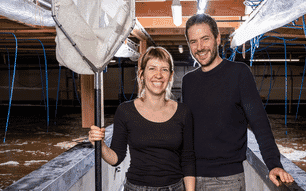A new study conducted by ICAR and published in the journal Aquaculture
has found that combining biofloc technology with an aquaponics system can achieve improved growth and welfare performance in tilapia without creating a heavy environmental footprint.

The researchers designed an integrated aquaponics and biofloc production system, hoping to create a zero waste and minimal input system to raise genetically improved farmed tilapia (GIFT) and bell peppers. Initial production results suggest that integrating the two systems yields better vegetable mass and gives tilapia a growth advantage over fish raised in a regular aquaponics system. The trial also demonstrates that the integrated system is less stressful for the fish, which provides multiple downstream benefits for producers.
The study
The researchers split 1,500 GIFT tilapia into four cohorts for the 120-day trial – one control group with 150 individuals per tank in an aquaponics set up for growing bell peppers. The three remaining groups were kept in an integrated biofloc and aquaponics system. The three experimental groups held fish at different stocking densities: T1 had 150 individuals per tank, T2 had 250 individuals and T3 contained 350 individuals. The researchers transplanted bell pepper seedlings into the aquaponic beds in all four cohorts and monitored vegetable growth.
The researchers tracked both the fish and the production environment over the course of the trial. When assessing water quality, the team monitored key parameters like pH and water temperature on a daily basis. They measured dissolved oxygen, total ammonia nitrogen, nitrite, nitrate and phosphate once every 10 days. Biofloc indicators like turbidity, floc volume and settling solids were assessed as well.
The researchers evaluated stress responses by taking blood samples from three fish per experimental group. They used serum cortisol and glucose levels as hormonal indicators of stress. They monitored liver tissue activity and catalase activity as additional welfare indicators.
Getting the benefits of both biofloc and aquaponics
No mortalities were recorded over the course of the trial. The researchers noted that tilapia kept in the integrated systems had a higher growth rate compared to fish in the control cohort. The trial also demonstrated an inverse relationship between stocking density and growth. The researchers felt that the decreased growth in T3 compared to the other groups was due to space limitations and fewer microbial flocs for the fish to feed on.

The T1 group had the best performance of all the groups – both in terms of fish health and vegetable growth. This tank also maintained the best water quality parameters over the course of the trial. The researchers noted that the water in the control group had the highest nitrate and nitrite concentrations – indicating poorer quality.
When assessing biological stress parameters in the tilapia, the researchers noted that cortisol levels, antioxidant response indicators like catalase and liver responses increased in line with stocking density. Their results also showed that liver enzyme activity and catalase were highest in the control group. They theorised that these indicators were lower for fish in the experimental groups because they were able to consume antioxidative elements in the bioflocs. Feeding on the flocs reduced their overall oxidative stress, leading to improved growth and welfare.
The researchers concluded that the integrated system had the best performance – especially when stocked at the optimum 150 tilapia per tank. The system produced more bell pepper mass with fewer water inputs, managed excess nutrient production from the fish and upcycled wastes for crop production. They concluded that this stocking density would give producers the best yield in terms of plant growth, fish health and overall yield.




